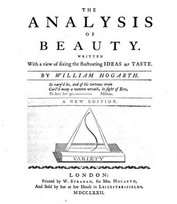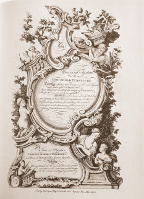 The first three plates in the Universal System of Household Furniture, the directory published by Ince & Mayhew between 1759 and 1762, contain Ornaments for Practice and include instructions for novice designers on how to draw. The first plate includes the following description: Plate I – containing several pieces of Foliage properly adapted to young beginners in their first practice of Drawing, being extremely necessary to bring the Hand into that Freedom required in all kind of Ornament, useful to Carvers, Cabinet-Makers, Chasers, Engravers, etc, etc. …. The next plate is called A Sistimatical Order of Raffle Leaf from the Line of Beauty and is described as a compleat Leaf of Foliage; the principal Sweep or Centre Line is that Foundation and Basis of the whole Order of Ornament; that must be first drawn and made perfect (which can only be done by freedom of Hand) before you proceed any further; It was interesting to learn from an article in the RIHA Journal[i], that William Hogarth was promoting the theory of the line of beauty in his book Analysis of Beauty which was published in 1753. He saw the line of beauty as an S-shape, or an inverted S-shape, which he considered conveyed liveliness and activity, which would excite the viewer. This was in contrast to straight lines, which were seen as inanimate. It is interesting to see William Ince used the phrase Line of Beauty and it would seem likely that Hogarth’s book was important to him when learning his trade. His apprenticeship with John West started in 1753, so the book would have just been available. Incidentally a raffle leaf was an architectural ornament. The Dictionary of Architecture and Landscape Architecture’s definition is: Serrated, indented, or crumpled leaf-like enrichment with waving indented frond-like (or raffled) edges. Raffling is applied to the notched edges of carved foliage in architectural ornament. I have also discovered that the Universal System of Household Furniture was not known to have been advertised in America until 1766. An advertisement appeared in the South-Carolina & American General Gazette (Charleston) on July 18, 1766. It read: “Robert Wells, At the Great Stationary and Book Shop on the Bay, has imported for sale Chippendale’s and Ince and Mayhew’s designs of household furniture from London.” The advertisement appeared again in 1772.[ii] [i] Anne Puetz, Drawing from Fancy: The Intersection of Art and Design in Mid-Eighteenth-Century London RIHA Journal [ii] Morrison H. Heckscher, English Furniture Pattern Books in Eighteenth-Century America http://www.chipstone.org/article.php/48/American-Furniture-1994/English-Furniture-Pattern-Books-in-Eighteenth-Century-America (Dixon, p.68, no.19).  Further to last week’s post, I had a look in the British Newspaper Archives for Ince & Mayhew and then searched again for Mayhew and Ince. The results supported my findings. The firm was called Ince & Mayhew, apart from the eighteenth century articles and advertisements which came out when the firm was still in existence, which referred to Mayhew and Ince. Any furniture for sale at auction stated Ince & Mayhew. Interestingly in the 1870s and 1880s there were a series of advertisements in many local papers looking for copies of furniture directories. They all read the same: OLD BOOKS WANTED on Cabinet Making by Hepplewhite, Ince and Mayhew, or Chippendale. Will give £2 2s for either….. The amount offered was sometimes £2 10s.The address given for replies was 41 Porchester Road, London, later Evering Road, Stoke Newington. In 1878 the advertisement appeared in the following papers: Bristol Mercury, Liverpool Mercury, Worcester Journal, Sheffield Independent, York Herald, Derbyshire Times and Chesterfield Herald, Leeds Times, Yorkshire Post and Leeds Intelligencer, Hampshire Advertiser, Belfast Telegraph. In 1879 it was in the Liverpool Mercury, in 1880 the Glasgow Herald and in 1881 the Gloucester Citizen, Bury Free Press, Leeds Times, Banbury Advertising and the Lancaster Gazette. On 12th May 1894 the Birmingham Daily Post ran a report on an Important Sale of Books at Sothebys at which The Universal System of Household Furniture consisting of 300 designs and 95 plates by Ince and Mayhew had been sold for £25[i], proving a very good investment for the collector. As reported last week, the 1762 edition of the Universal System was specially scarce and a copy in perfect condition was priced by Batsfords in 1940 at £150[ii]. In 1996,Christie’s sold a copy of an intermediate issue, dated about 1765, for £6,325 and in 2011 they sold a copy for £8,125. A first edition, dated 1760, was sold by Bonhams in 2013 for 6500 USD (£4,973 ) and a copy was sold by them from the library of the late Hugh Selbourne, M.D. in 2015 for £6,875 including premium. What has astonished me though is a copy of the Universal System being sold by Potterton Books of York, London and New York for £18,000. This version is printed on twentieth century mottled calf, has gilt decorative borders and red morocco lettering pieces. It is described as a Handsome book. William Ince invented and drew 75 of the 95 plates as well as the title page and I’ve been looking at some of them in my Dover Publications edition. Items such as the library steps and the Ladies’ Dressing Table are really delightful! [i] According to the National Archives Currency Converter, £25 in 1890 would be worth close on £1500 in 2005. £2 2s would be roughly £100. [ii] Davis, Frank, The World of Art in Wartime, Furniture “Convenient to the Nobility and Gentry The Illustrated London News on 25th May 1940. |
Author
Sarah Ingle is the great great great great grand-daughter of William Ince and has been researching her family history for a number of years. She thoroughly enjoyed the detective work involved in tracing William’s lineage. Archives
December 2022
Categories |

 RSS Feed
RSS Feed